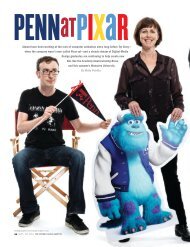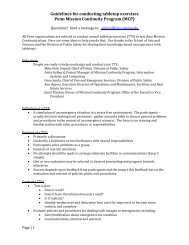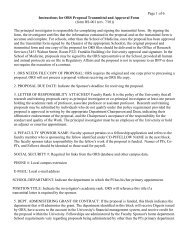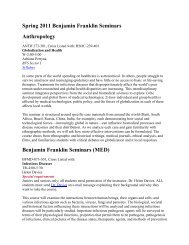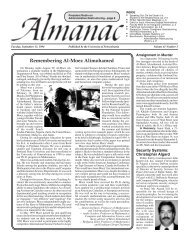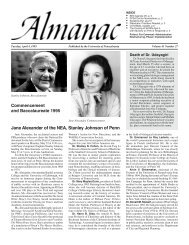Download this article (PDF) - University of Pennsylvania
Download this article (PDF) - University of Pennsylvania
Download this article (PDF) - University of Pennsylvania
Create successful ePaper yourself
Turn your PDF publications into a flip-book with our unique Google optimized e-Paper software.
36 MARCH | APRIL 2013 THE PENNSYLVANIA GAZETTE<br />
Constructing
a New Kahn<br />
Louis Kahn had more or less<br />
completed his designs for Franklin<br />
D. Roosevelt Four Freedoms Park<br />
when he died in 1974. It finally<br />
opened last fall to glowing<br />
reviews—but it could easily have<br />
been a disaster. Or nothing.<br />
By Samuel Hughes<br />
THE Roosevelt Island. Bill Whitaker, the curator and<br />
October rain was slanting down by the time<br />
the car from Philadelphia crossed the bridge to<br />
collection manager <strong>of</strong> Penn’s Kroiz Gallery and Architectural<br />
Archives, was at the wheel. Though the snarly New York traffic<br />
hadn’t fazed him, he was starting to experience some palpitations<br />
now that he had reached the narrow island in the East River.<br />
His destination was Four Freedoms Park, the near-mythical<br />
monument to Franklin Delano Roosevelt designed by Louis<br />
Kahn Ar’24 Hon’71, the legendary architect and Penn pr<strong>of</strong>essor.<br />
The four-acre memorial was the last project Kahn designed, and<br />
the fact that its ribbon-cutting ceremony was just two weeks<br />
away was prompting numerous variations on the word miracle.<br />
PHOTOGRAPHY BY DON HAMERMAN<br />
THE PENNSYLVANIA GAZETTE MARCH | APRIL 2013 37
Consider the circumstances: First announced in early 1973, it As they walked past the decrepit 1850s smallpox hospital known<br />
went through major changes in scope and materials as Kahn’s as the Renwick Ruin and approached the row <strong>of</strong> copper beeches<br />
vision adjusted to budgetary realities and his clients’ taste. standing sentinel at the park’s entrance, Whitaker could sense<br />
Then in March 1974, shortly before the final schematic designs Pattison’s anxiety. She had been cut <strong>of</strong>f from the project for nearly<br />
were approved, Kahn suffered a fatal heart attack in a Penn 40 years, and the one time she had been asked to attend a meeting<br />
Station men’s room. His debt-strapped Philadelphia <strong>of</strong>fice was with the key players two decades ago, her frustrations had spilled<br />
promptly shuttered, and most <strong>of</strong> his employees—including out. She was not asked back, and her isolation from the project<br />
some key colleagues—were let go. Mitchell/Giurgola Architects’ only grew. By now she was dreading what she might find.<br />
New York <strong>of</strong>fice, run by Kahn’s friend Aldo Giurgola, took over “I think anyone who’s been involved in architecture, when<br />
the project, but the following year New York City was rocked by you go and visit a building under construction, when it’s being<br />
an epic financial crisis. Between that and a series <strong>of</strong> changing finished—and you were a part <strong>of</strong> it—you get incredibly excited,”<br />
political administrations and sympathies, Four Freedoms Park says Whitaker, whose thick head <strong>of</strong> brown-gray hair and steady<br />
was more or less dead in the East River for more than three gaze somehow combine to suggest a boyish unflappability.<br />
decades, its empty site coveted by developers.<br />
“Because you see all the wonder—and all the flaws.”<br />
Building anything designed by a dead<br />
architect is considered a fool’s errand. By<br />
the time the plans got jump-started seven<br />
years ago, the world—and certain codes<br />
relevant to architecture—had changed.<br />
Kahn was famous for last-minute alterations,<br />
and he might well have made some<br />
more had he lived. Yet any interpretations<br />
<strong>of</strong> his vision by others were bound<br />
to stir powerful passions.<br />
Over the past few years, Whitaker had<br />
become deeply involved in the project.<br />
Trained as an architect himself, and<br />
intimately familiar with Kahn’s work<br />
(the Kahn Collection forms the keystone<br />
<strong>of</strong> the Architectural Archives and represents<br />
the most significant repository <strong>of</strong><br />
Kahn materials in the world), Whitaker<br />
had painstakingly recreated the evolution<br />
<strong>of</strong> Four Freedoms Park. His scholarly<br />
detective work—call it forensic architecture—would<br />
prove invaluable.<br />
Bill Whitaker: “If you don’t use the Kahn Collection for a project like <strong>this</strong>, why have it in the first place?”<br />
Now, on <strong>this</strong> rainy October morning,<br />
Whitaker suddenly had a sobering realization—that<br />
despite having given hundreds <strong>of</strong> tours <strong>of</strong> Kahn’s By the time Four Freedoms Park opened on October 17—with a<br />
buildings over the years, <strong>this</strong> was the first time he had ever ribbon-cutting ceremony presided over by Bill Clinton, Michael<br />
visited one that was brand new. And in just a few hours he would Bloomberg, Andrew Cuomo, and Tom Brokaw—few architectural<br />
critics were finding flaws. On the contrary; the critical<br />
be leading a tour <strong>of</strong> the memorial for a large contingent <strong>of</strong> Penn<br />
Design alumni and friends—not exactly a lightweight crowd, reviews bordered on the ecstatic.<br />
since many had known Kahn personally, some had studied “It gives New York nothing less than a new spiritual heart,”<br />
under him, and all revered him and his work.<br />
wrote Michael Kimmelman in the September 12 New York<br />
The two passengers in Whitaker’s car had even deeper connections.<br />
One was Harriet Pattison GLA’67, the landscape architect the prow <strong>of</strong> a ship and a retreat for meditation.”<br />
Times. “It creates an exalted, austere public space, at once like<br />
and romantic companion <strong>of</strong> Kahn who had worked closely with him “It is the first time a work <strong>of</strong> posthumous architecture has<br />
on the landscape side <strong>of</strong> the memorial for the last 13 months <strong>of</strong> his made me feel elated, not <strong>of</strong>fended, and left me absolutely certain<br />
life, only to be let go a few days after his death. The other was their that the right thing had been done,” wrote Vanity Fair critic Paul<br />
son, Nathaniel Kahn, whose brilliant, poignant film, My Architect: Goldberger, after listing some <strong>of</strong> the sobering challenges that face<br />
A Son’s Journey, is widely credited with bringing his father’s work anyone trying to realize a dead architect’s vision. “Kahn designed<br />
to a broad audience—and with rekindling interest in the moribund buildings that were modern and at the same time looked as if<br />
FDR memorial. In recent years Whitaker had gotten to know both <strong>of</strong> they had been there forever,” he added. “Build it in 1974, build it<br />
them well, and the more he learned the more he came to appreciate in 2012—when it is Louis Kahn it doesn’t seem quite to matter as<br />
the vital but unknown role Pattison had played in the memorial’s much as it would with some other architect’s work.”<br />
design. She had also given the archives more than 100 drawings And yet little things, as well as big, mattered terribly to<br />
and other materials pertaining to the project.<br />
Kahn—from the precise texture <strong>of</strong> concrete or stone to the<br />
38 MARCH | APRIL 2013 THE PENNSYLVANIA GAZETTE
(Above) Freedoms amid the lindens.<br />
(Left) Kahn amid the conifers, 1973.<br />
THE ARCHITECTURAL ARCHIVES, UNIVERSITY<br />
OF PENNSYLVANIA, PHOTO BY BEVERLY PABST<br />
precision <strong>of</strong> its setting and its relationship to its surroundings.<br />
If God is in the details, so, too, is the Devil.<br />
“Kahn’s architecture is hard,” says Gina Pollara, the project’s<br />
executive director, who had the formidable challenge <strong>of</strong> making<br />
sure the memorial was built just right and on time while<br />
steering it through the shoals <strong>of</strong> competing interpretations.<br />
“I’ve come to appreciate that all these little tiny things add<br />
up to a whole. As Beckett says, ‘Grain upon grain, one by one,<br />
and one day, suddenly, there’s a heap.’”<br />
IN<br />
a<br />
<strong>of</strong> course, is Roosevelt, whose<br />
sense, Four Freedoms Park<br />
is a memorial to two men. One,<br />
life and political career were still a tremendous<br />
source <strong>of</strong> inspiration for many<br />
in the early 1970s.<br />
“Roosevelt was a person who didn’t want<br />
monuments,” says former Ambassador<br />
William vanden Heuvel, chair <strong>of</strong> Franklin<br />
D. Roosevelt Four Freedoms Park and<br />
the driving force behind the project.<br />
“He <strong>of</strong>ten said that the only monument<br />
he wanted was a slab <strong>of</strong> marble six-foot<br />
long and four-foot wide in front <strong>of</strong> the<br />
archives <strong>of</strong> the United States, with simply<br />
his name and dates on it. But I think the<br />
country felt that he was the greatest president in the 20th<br />
century. It had always been on my agenda to see if we could<br />
build a memorial to him.”<br />
The park is also a memorial <strong>of</strong> sorts to Kahn, whose reputation<br />
as an architect’s architect in his lifetime has since swelled<br />
to include many casual but equally ardent admirers.<br />
“For the design team, it was a Kahn project,” says Michael<br />
Rubenstein GAr’60 GCP’60 GFA’60, who served as the project<br />
architect in 1974-75 following Kahn’s death, and for several<br />
THE PENNSYLVANIA GAZETTE MARCH | APRIL 2013 39
years as an un<strong>of</strong>ficial consultant when the memorial came<br />
back to life. “And for the client it was a Roosevelt project. It’s<br />
really fascinating.”<br />
Of course, there was a good deal <strong>of</strong> overlap between the two. Kahn,<br />
a Jewish immigrant from Estonia, had revered Roosevelt for his I had <strong>this</strong> thought that a memorial should be a Room and<br />
leadership and his championing <strong>of</strong> the common man—and for the a Garden. That’s all I had … I just chose it to be the point <strong>of</strong><br />
employment opportunities his New Deal programs had provided. departure. The Garden is somehow a personal nature, a personal<br />
Sue Ann Kahn CW’61 recalls that when she was growing up, she was kind <strong>of</strong> control <strong>of</strong> nature, a gathering <strong>of</strong> nature. And the Room<br />
“continually told how important Roosevelt was for our country, for was the beginning <strong>of</strong> architecture [and] an extension <strong>of</strong> self.<br />
the world, and for our family.” Most <strong>of</strong> her father’s early architectural<br />
practice was devoted to “uplifting people’s lives through the<br />
—LOUIS KAHN, FROM A LECTURE GIVEN AT THE PRATT INSTITUTE IN 1973.<br />
enlightened design <strong>of</strong> public housing and community planning,” she New York City is not exactly Big Sky Country, but out in the<br />
adds, and “many <strong>of</strong> the projects he worked on or spearheaded were<br />
middle <strong>of</strong> the East River, the moniker doesn’t seem so farfetched.<br />
When you arrive at Four Freedoms Park and look<br />
funded by Roosevelt’s Public Works Administration, Resettlement<br />
Administration, and other arms <strong>of</strong> the New Deal.”<br />
up from the base <strong>of</strong> the 100-foot-wide granite stairs, you might<br />
Though she was only five years old on April 12, 1945, she find yourself thinking about the proverbial stairway to heaven.<br />
remembers that evening well. The radio had been brought to From the top <strong>of</strong> the stairs, facing south, you look down a long,<br />
the dining room. “Suddenly my mother, my parents, everybody sweeping, triangular lawn, flanked on either side by allées <strong>of</strong><br />
stood up, silent, heads bowed. Dinner was abandoned. I was little-leaf lindens. Your eye is drawn to a distant … something.<br />
told that Roosevelt had died.”<br />
At first, because <strong>of</strong> the distance and the eye-widening frame<br />
Rubenstein was eight that night, and when he heard the <strong>of</strong> river and sky and skyline (Queens and Brooklyn on one<br />
news at a restaurant, he said to himself: “We have to build a side, lower Manhattan on the other), you might not be able<br />
monument to Roosevelt.”<br />
to tell what that something is. But as you approach it, either<br />
40 MARCH | APRIL 2013 THE PENNSYLVANIA GAZETTE
across the grass or along the side paths<br />
on either side <strong>of</strong> the allées, and reach the<br />
triangular forecourt, you find yourself<br />
facing a large granite niche in which sits<br />
an oversized, disembodied bronze head<br />
<strong>of</strong> Roosevelt. He looks pensive, even a bit lonely, above the<br />
simple inscription: Franklin Delano Roosevelt 1882 -1945.<br />
From there you enter the three-sided Room. Open on its south<br />
side to a glittering expanse <strong>of</strong> water and light and a Lower<br />
Manhattan skyline that prominently features the United Nations<br />
building, its only ro<strong>of</strong> is the sky. There is no railing to block your<br />
view—just a ha-ha, a sort <strong>of</strong> granite trench at the prow <strong>of</strong> Kahn’s<br />
ship that seems to erase the boundary between its granite deck<br />
and the river. Behind you now, inscribed on the south-facing<br />
side <strong>of</strong> the statue niche, is an excerpt from Roosevelt’s 1941<br />
“Four Freedoms” speech, whose words give a hint <strong>of</strong> his ability<br />
(Above) Monumental stairs, trees, skyline.<br />
(Left) The not-so-Brazen Head <strong>of</strong> FDR greets<br />
visitors. (Far left) Mystery and Melancholy<br />
<strong>of</strong> a Room.<br />
to inspire a nation that was then slogging<br />
from Depression to war.<br />
The walls <strong>of</strong> the 60-foot-square Room<br />
are 12 feet tall—yet everything about it is<br />
both monumental and somehow … light.<br />
Its massive columnar cubes <strong>of</strong> granite are<br />
each separated by an inch, and the surfaces<br />
between them are honed to a reflective<br />
sheen, which allows the light to penetrate<br />
and dazzle. The faces are wire-sawn, to<br />
roughen their texture and capture subtle<br />
shades <strong>of</strong> light (and, in rain and fog, an<br />
almost sensuous patina). Clearly, you<br />
think, granite was the only medium that<br />
Kahn could have chosen for the Room.<br />
Except that it wasn’t. Stone was not his<br />
first choice <strong>of</strong> material. It wasn’t even his<br />
second. As with so many things about<br />
Four Freedoms Park, there was a remarkable<br />
amount <strong>of</strong> evolution, change, refinement,<br />
driven by concerns both budgetary<br />
and esthetic. Had he lived longer, who<br />
knows what else might have changed?<br />
Sitting at a long table in the Architectural<br />
Archives, Harriet Pattison<br />
looks shyly stylish in a brown sweater<br />
with a dark, high collar. Beside her<br />
are Nathaniel, a portrait <strong>of</strong> thoughtful<br />
intensity as he listens to and occasionally<br />
prompts his mother, and Whitaker,<br />
who lays out a series <strong>of</strong> sketches and<br />
models and documents before her as we<br />
talk. Some <strong>of</strong> the drawings are Kahn’s,<br />
many are hers, and they are kindling<br />
memories, most <strong>of</strong> them warm.<br />
February 20, 1973. She remembers the<br />
day well. It was Kahn’s 72nd birthday,<br />
and the day he brought the proposal for<br />
the memorial into her <strong>of</strong>fice.<br />
“I spent five hours on it,” she says, her<br />
memory precision-honed by the time cards<br />
in the archives. “I remember how Lou came<br />
in, pushed aside the stuff that I was working<br />
on, and laid out photographs and a site<br />
plan, a survey—just laid them out like a<br />
stack <strong>of</strong> cards and told me about it.<br />
“He was very excited,” she adds. “So was I. It was the best possible<br />
commission you can have.” Kahn’s proposal for the John<br />
F. Kennedy Library in Washington had recently been turned<br />
down, she recalls, as had one for another FDR memorial in that<br />
city. But <strong>this</strong> commission “was a great honor,” and the site had<br />
tremendous potential—especially for a landscape architect.<br />
“It had to involve landscape,” she says. “It was four acres.<br />
So unless you were building the Pentagon or something, you<br />
wouldn’t cover it altogether with architecture, although just<br />
an architect was hired for the job. So it was, from the beginning,<br />
a landscape and architecture thing.”<br />
THE PENNSYLVANIA GAZETTE MARCH | APRIL 2013 41
While the location was “fantastic, both because <strong>of</strong> exposure “When you arrived, I had a circle <strong>of</strong> [European] hornbeams and<br />
and the views,” it also presented some challenges. The long, thin, a staircase,” she explains. “I had a sycamore grove, to go with the<br />
crocodile snout <strong>of</strong> land on which it was to be built was basically scale <strong>of</strong> the Renwick Ruin because that was massive. And for an<br />
a “dump,” formed from rock excavated from the subway tunnel<br />
beneath the river. In addition to being “featureless and monumental and Old World. Ancient world, in fact.”<br />
entrance, I chose cedars <strong>of</strong> Lebanon, because they’re absolutely<br />
level,” its narrow shape meant that “you couldn’t go anywhere,” There was one problem with the Bastion, though. It would have<br />
she explains. “You could go up, which is the first move that I pushed the cost <strong>of</strong> the project to more than $6 million. The construction<br />
budget was $2.5 million. So much for stainless steel and<br />
made, to raise the ground and make a mount and exaggerate<br />
it and feather it down to the tip. Which is where Lou located 60-foot walls.<br />
the architecture, at the terminus.”<br />
Kahn then switched to a scaled-down structure made <strong>of</strong><br />
The first serious design for the Room, which Kahn developed<br />
in March and April 1973, was a “monumental fortress,” Art Museum in Texas (for which Pattison was the landscape<br />
concrete, which he had used to brilliant effect at the Kimbell<br />
in Pattison’s words. The walls were 60 feet high, with a “very architect) and the Salk Institute in California. He also introduced<br />
cantilevers and other new design elements into the<br />
broad” footprint, roughly 90 feet square. The building material?<br />
Brushed stainless steel.<br />
Room, which would have been open on two sides.<br />
“I called it the Bastion,” she says. “But it was in stainless As with brick and every material he worked with, he had very<br />
steel, which is kind <strong>of</strong> miraculous—and pretty Frank Gehry. specific notions about concrete’s personality.<br />
And huge—it was a circle inside <strong>of</strong> a square, which was kind <strong>of</strong> “He was sensitive to the color <strong>of</strong> concrete—Portland cement<br />
a typical plan <strong>of</strong> Lou’s. It was a whole theater <strong>of</strong> activity, with from the East Coast versus West Coast,” says Whitaker. “The<br />
niches and balconies—just a great gathering place.”<br />
East Coast stuff was greener. He didn’t like that. It was too<br />
Compared with Kahn’s usual solid austerity, she adds, that cool. He preferred the warmer tone.”<br />
design was “gossamer—and very electrifying.”<br />
For a visionary dreamer, Kahn was also a “practical architect,”<br />
one who wouldn’t compromise but would change, says<br />
Pattison describes her early landscape design as “baroque<br />
and fantastic,” large in scale and “grandiose.”<br />
Nathaniel. “Rather than say, ‘Oh, I can’t build the Bastion for<br />
$6.5 million, so what kind <strong>of</strong> material could we use to build<br />
The allées and the lawn help create a meditative sanctuary<br />
it for $2.5 million?’ he’d say, ‘Well, we can’t do my dream. Let<br />
between Manhattan and Queens.<br />
me come up with a new dream.’”<br />
42 MARCH | APRIL 2013 THE PENNSYLVANIA GAZETTE
“We had to come up with something totally different,”<br />
explains Pattison, who wrote a four-page outline around that<br />
time describing their vision for what had now become the<br />
four sections <strong>of</strong> the memorial: the Room and the Statue, the<br />
Garden, the House <strong>of</strong> the Garden, and the Grove. All the amenities<br />
that had been planned for the Bastion were to be moved to<br />
the House—a sort <strong>of</strong> underground reception space and arcade<br />
with an “immense glass façade” and an “intimate, exuberant<br />
‘Rose Garden’” above the arcade. The Grove, which also went<br />
through numerous iterations before being scrapped, would<br />
have been at the north end <strong>of</strong> the park, forming an interface<br />
with the Renwick Ruin.<br />
The idea “definitely was theater,” she says. “And it was a<br />
narrative. I wanted people to come and have a journey through<br />
the American continent, through <strong>this</strong> mystery.” When you<br />
arrived at the top <strong>of</strong> the stairs, you wouldn’t “see Last Year at<br />
Marienbad or Kaiser Wilhelm on a horse, but you saw a village<br />
green that was very American.” And, in the distance, “you just<br />
see the head <strong>of</strong> Roosevelt, the way you’d see him on a coin, the<br />
way we knew him—disembodied—on the radio broadcasts.”<br />
William Walton, the chair <strong>of</strong> the Washington Fine Arts<br />
Commission who had originally recommended Kahn for the<br />
project, was the one who suggested using the bronze head <strong>of</strong><br />
FDR created by sculptor Jo Davidson, a contemporary <strong>of</strong> the<br />
president’s, Pattison notes. “But it was Lou’s idea to enlarge<br />
it, to play with scale and put it in a niche—welcoming people,<br />
welcoming new arrivals. Just an intimate, individual kind <strong>of</strong><br />
greeting—but then you wanted to get beyond that to <strong>this</strong> sort<br />
<strong>of</strong> mystery <strong>of</strong> what was beyond, which was the Room.”<br />
The realistic sculpture <strong>of</strong> FDR’s head was not the only idea<br />
considered for that space. A model from January 1974 shows<br />
an allegorical figure intended to suggest the Four Freedoms<br />
in the south side <strong>of</strong> the sculpture niche.<br />
“Lou originally had an allegorical figure in the Room,” says<br />
Pattison. “We both liked [Italian sculptor Giacomo] Manzù’s<br />
work, and Lou was going to investigate and see Manzù. But<br />
he was definite about keeping any kind <strong>of</strong> image <strong>of</strong> Roosevelt<br />
outside, so it didn’t become a ritual sanctuary.”<br />
The sense <strong>of</strong> mystery one feels in the Room is “really confrontation<br />
with one’s self,” she suggests. “And you turn back, and you<br />
see the inscriptions about freedom and reflect on that and what<br />
your role could be, so that there’s a responsibility there that’s given<br />
to you. You can’t escape, either. You have to return, which is very<br />
different from most memorials. It’s a sense <strong>of</strong> eternity.”<br />
By the summer, the proposal with the concrete Room seemed to<br />
be moving full speed ahead. But after Kahn’s presentation on July<br />
31, Edward Logue, head <strong>of</strong> the New York State Urban Development<br />
Corporation, fired a torpedo into the memorial’s concrete prow.<br />
“Basically the [Roosevelt] family, and Logue in particular, made<br />
the decision that it had to be stone,” explains Whitaker. “In the<br />
end, the client just didn’t believe that concrete was an appropriate<br />
material for a memorial.” Kahn tried to persuade them otherwise,<br />
suggesting that Logue go to the Salk Institute and see how that<br />
THE PENNSYLVANIA GAZETTE MARCH | APRIL 2013 43
looked. Logue was unswayed. Even though he and the Roosevelt walking under them anymore. It was a devastation, the way he<br />
family liked certain aspects <strong>of</strong> the Room, including the cantilevers tore away at the Garden.”<br />
and the baldacchinos (a sort <strong>of</strong> canopy), “they just didn’t want it It’s fair to say that Pattison was not thrilled with that development.<br />
in concrete,” says Whitaker. “They wanted it in stone.”<br />
“I hated it,” she says. “He made a little drawing for me, and when<br />
Of course, for Kahn it wasn’t a matter <strong>of</strong> simply scratching I saw it, I just felt, Oh, no. It was like a mausoleum. I described it as<br />
out the word concrete and substituting stone. For one thing, funereal because [there] was just one slot, one way, one movement.<br />
some key design elements, such as the cantilevers, could not be There was no variety. Everything was X’d out. The landscape was<br />
structurally supported using stone. More to the point, Kahn—who gone. You were completely enclosed, right down to the end.”<br />
according to Whitaker “had really never built in monumental Given the direction it was heading, she was relieved to get<br />
stone before”—had to know it, to learn the textures and soul away from Four Freedoms Park and move on to something<br />
<strong>of</strong> <strong>this</strong> medium. He settled on granite, specifically wire-sawn else—in <strong>this</strong> case, the Abbasabad project in Tehran that Kahn’s<br />
granite from any <strong>of</strong> three quarries he had selected—one <strong>of</strong> which, <strong>of</strong>fice was developing.<br />
in Mount Airy, North Carolina, would be used.<br />
But what the client taketh away, the client also giveth. On<br />
The new plans went through a number <strong>of</strong> changes, some <strong>of</strong> November 20, explains Whitaker, “the clients read him the riot<br />
them pr<strong>of</strong>ound.<br />
act, saying, ‘We don’t like the Garden at all. We think the Room<br />
In August, for example, Kahn wrote a warm letter to Harriet works really well, but we want you to go back to that [previous]<br />
and 10-year-old Nathaniel (vacationing in Maine) that included scheme for the Garden.’ So Harriet’s the one who goes back<br />
a tiny, detailed sketch for the memorial with a stone Room, and makes the bridge between that early scheme, where they<br />
complete with columns. On the same page is an equally tiny had been, and ultimately where they were going.”<br />
sketch <strong>of</strong> the Garden, which still included the House underneath<br />
it, along with notes about the “green lawn” and the back. Lou had 10 days to come up with something, to restore it.<br />
“I was really elated,” says Pattison convincingly. “I was called<br />
“rising path flanked by trees on either side.”<br />
At that point, <strong>of</strong> course, the House had been eliminated. They<br />
But he soon became uncomfortable with much <strong>of</strong> the Garden, also wanted to lower the mount somewhat and had a series<br />
and started over—eventually taking a belt sander to a wooden <strong>of</strong> steps over the lawn. I brought back the trees, number one,<br />
model he had built and scouring away so much <strong>of</strong> the landscaping<br />
that it ended up looking like some kind <strong>of</strong> minimalist She also brought Kahn a photograph <strong>of</strong> Le Nôtre’s hundred<br />
and really bushed it up.”<br />
African mask.<br />
stairs at Versailles. “It goes up to the clouds,” she says. “That <strong>of</strong><br />
“Lou literally cut away the model,” says Nathaniel. “And everybody<br />
freaked out about it. Certainly it freaked out my mother, a grand staircase, with the excitement <strong>of</strong> going up the stairs,<br />
course harkened back to his Beaux Arts [training], so he created<br />
because the Garden really was literally eviscerated. The center not knowing what you’re going to see beyond.”<br />
was scooped out <strong>of</strong> it. There were still trees, but you weren’t Careful study <strong>of</strong> multiple drawings by Kahn and Pattison<br />
44 MARCH | APRIL 2013 THE PENNSYLVANIA GAZETTE
convinced Whitaker <strong>of</strong> her key role in the development <strong>of</strong> <strong>this</strong><br />
last plan. “I suddenly figured out these are Harriet’s drawings<br />
that show the shift in that November/December model,” says<br />
Whitaker. “Harriet’s the one who’s throwing down the first<br />
ideas and making the shift. So who does Lou turn to when he<br />
has to redesign the Garden? Harriet. Is it exactly what Kahn<br />
decided? No. Kahn made some differences. But the stairs—the<br />
kind <strong>of</strong> grand set <strong>of</strong> steps? That’s sketches Harriet made.”<br />
She had another idea that should not be forgotten: a canal,<br />
separating the park from the ruins just to the north.<br />
“I thought, ‘Hmm, why not bring in the water, and then have<br />
bridges which would control the entrance, and have a series<br />
<strong>of</strong> steps here so that you could go under the bridges?’” she<br />
recalls. “You could arrive by boat, which I think would be very<br />
exciting, and make these two bridges the entrance. Because<br />
we had not resolved the entrance at that point.”<br />
The Room was still evolving as well. Nathaniel Kahn has a<br />
vivid memory <strong>of</strong> being at his father’s <strong>of</strong>fice at 1501 Walnut<br />
Street one autumn night when both his parents were working<br />
intently on the project.<br />
“I remember Lou working on and thinking about the Room,” he<br />
says. “There was a [wooden] model, and the wall was divided into<br />
two, and it had a slit. At one point it was at an angle to let sun in<br />
at certain times <strong>of</strong> the year, and other times it was straight. And<br />
he was pulling the wall apart and putting it back together. And<br />
he asked me, ‘How far apart do you think it should be?’”<br />
Nathaniel, who only turned 11 that November, was thrilled to be<br />
asked. “But more than expecting the right answer from me, it’s sort<br />
<strong>of</strong> a window into the way that he thought about things and the way<br />
he worked,” he says. “He liked to talk as he worked. And it didn’t<br />
matter whether you were young or old or an architect or not. He<br />
wasn’t necessarily interested in your solution, but he was interested<br />
in what a conversation with you might bring out for him.”<br />
The memory has the quality <strong>of</strong> a fairy tale, he says: “The wise<br />
old philosopher king wants to know what the right move is, and<br />
who does he choose but a little boy to ask a question <strong>of</strong>. Somehow,<br />
in engaging the little boy, he comes up with some ideas. And by<br />
the time I have that specific memory from working on the Room,<br />
it had already become very close to what it is today.”<br />
Sunday, March 17, 1974. Kahn had just arrived back in New<br />
York from Ahmadabad, India, where the Indian Institute<br />
<strong>of</strong> Management he had designed was under construction.<br />
He was about to catch a train to Philadelphia in order to teach<br />
his Monday classes at Penn. Then, in a<br />
Penn Station men’s room, his entangled<br />
heart gave out. It took three days before<br />
his family and friends and colleagues<br />
found out what had happened to him.<br />
The story <strong>of</strong> his complicated personal life<br />
has been told many times, most movingly<br />
in My Architect. In addition to Sue Ann<br />
(his daughter by his wife, the late Esther<br />
Israeli Kahn Ed’27 G’33) and Nathaniel,<br />
he also had a daughter, Alexandra Tyng<br />
GEd’77, with the late architect Anne Tyng<br />
Gr’75 [“Journey to Estonia,” Jan|Feb 2007].<br />
His death was obviously very hard on all <strong>of</strong><br />
(Left) Harriet Pattison in the Room. (Below)<br />
One <strong>of</strong> her many sketches for the memorial.<br />
(Far left) “Consider the momentous event in<br />
architecture when the wall parted and the<br />
column became.”<br />
THE ARCHITECTURAL ARCHIVES, UNIVERSITY OF PENNSYLVANIA<br />
THE PENNSYLVANIA GAZETTE MARCH | APRIL 2013 45
them. But on a pr<strong>of</strong>essional level it had to have been particularly “We were part <strong>of</strong> that team starting in ’74, and finished the<br />
devastating for Harriet Pattison. Not only had she just lost her working drawings in ’75 when it was stopped,” she says. “I<br />
mentor and soul mate and the father <strong>of</strong> her son, but she was suddenly<br />
out <strong>of</strong> a job. Of course, so were many others. But still … with Lou, and John was communicating to my partner and<br />
worked very closely with John Haaf, who had worked directly<br />
It is not a time or emotional state that Pattison cares to revisit.<br />
“It’s just the way it is,” she says quietly, looking away. layers that we were not understanding. And I never heard the<br />
myself what Lou said. So I never felt that there were any hidden<br />
“It’s so sad, in retrospect,” says Whitaker. “There was no forethought<br />
to what was being lost when she was asked to leave nothing about anything prior to my involvement in it.”<br />
name Harriet mentioned. I just worked with John and knew<br />
and her ties severed with the <strong>of</strong>fice. I think she didn’t have The drawings “were done to the best <strong>of</strong> John Haaf’s and my ability<br />
to carry forward all <strong>of</strong> the ideas that Kahn had left, and the only<br />
the protector anymore. She was not welcome anymore, and<br />
she couldn’t help. And the isolation that came from <strong>this</strong>, I firsthand knowledge that any <strong>of</strong> us had was through John,” says<br />
think, was pr<strong>of</strong>ound.”<br />
Rubenstein. “No one ever thought, ‘Well, we should ask Harriet<br />
what [Kahn] was thinking.’ It wasn’t part <strong>of</strong> the equation. I know<br />
Michael Rubenstein was working for Mitchell/Giurgola when that’s a sore spot with Nathaniel—and it should be. I mean, he’s<br />
Kahn died. After Aldo Giurgola agreed to have his New York their son. But at any rate, the project got to the point that we all<br />
<strong>of</strong>fice take over Four Freedoms Park, Rubenstein became the felt it could be built and look like something that had been not<br />
project architect until the money ran out in 1975.<br />
only designed but thought thoroughly through by Lou Kahn.”<br />
Giurgola “understood a lot about what Kahn was talking Haaf later moved to a remote area <strong>of</strong> British Columbia, where<br />
about, and he also understood the way he drew and thought,” Whitaker tried, unsuccessfully, to reach him. He died last year,<br />
says Rubenstein, who had greatly admired Kahn since his just seven months before Four Freedoms Park was dedicated.<br />
grad-student days at Penn.<br />
Rubenstein worked with the late John Haaf, a former Kahn Several things helped keep the dormant memorial alive in the<br />
associate then working for David Wisdom and Associates in public consciousness. One was “Louis I. Kahn: In the Realm <strong>of</strong><br />
Philadelphia, which partnered with Mitchell/Giurgola. Between Architecture,” a major exhibition co-curated by Penn pr<strong>of</strong>essors<br />
David Brownlee (art history) and David DeLong GAr’63<br />
them, he adds, “the project went from the design development<br />
drawings to a complete set <strong>of</strong> working documents—in other (architecture), which opened at the Philadelphia Museum <strong>of</strong> Art<br />
words, that could go out for bid.”<br />
in 1991 and at the Museum <strong>of</strong> Modern Art the following summer.<br />
Then, in April 1993, Alyce Russo, director <strong>of</strong> planning and<br />
Lois Sherr Dubin LAr’61, who also remembers Kahn as an<br />
inspirational figure during her Penn days, became the landscape<br />
architect for the project when Mitchell/Giurgola selected (RIOC), convened a workshop that included some <strong>of</strong> the key<br />
development for the Roosevelt Island Operating Corporation<br />
her firm, Villa/Sherr.<br />
players for Four Freedoms Park. In attendance were the two<br />
46 MARCH | APRIL 2013 THE PENNSYLVANIA GAZETTE
landscapers, Pattison and Sherr Dubin. Ostensibly the meeting<br />
was about the immediate matter <strong>of</strong> shaping the rough site and<br />
preparing it for construction. But other issues soon surfaced.<br />
One concerned recent building-code changes regarding<br />
handicapped access, a subject that resonates in light <strong>of</strong> FDR’s<br />
own reliance on wheelchairs. That wasn’t a problem in the<br />
entrance area and the Garden, since one can easily bypass the<br />
stone staircase using the pathways on either side <strong>of</strong> the lawn.<br />
When you get to the Room, though, it’s trickier, since there are<br />
stairs leading down to the ha-ha area. Despite objections by<br />
Pattison and others at that workshop, the Mitchell/Giurgola<br />
architects added ramps to the drawings.<br />
the tops,” she says. “So we’re going to control the height.” And<br />
when Hurricane Sandy roared through shortly after the opening<br />
ceremony, “we didn’t lose a tree,” she adds with palpable<br />
relief. “I think we hardly lost a twig.”<br />
During that 1993 meeting, though, Pattison felt that the arboreal<br />
aspects <strong>of</strong> the landscaping had gone down the wrong path,<br />
and she let her displeasure be known.<br />
“I was pretty vehement, and I wasn’t very nice,” she says. “I<br />
wasn’t asked back.” She doesn’t want to say anything more<br />
about it, and neither does Sherr Dubin.<br />
(Above) Lois Sherr Dubin, framed by little-leaf lindens. (Right)<br />
Looking north along the allées toward the Renwick Ruin and the<br />
Queensboro Bridge. (Left) Shadows along the allée.<br />
Then there were the trees. During the months that Pattison<br />
and Kahn had worked on the Garden, the projected size, configuration,<br />
spacing, and species <strong>of</strong> trees for the allées underwent<br />
a number <strong>of</strong> changes. (Kahn’s last known words on the<br />
subject were that the trees “should be <strong>of</strong> a low, overhanging<br />
type which would require little or no clipping.”) While littleleaf<br />
lindens were considered, Pattison and Whitaker say they<br />
were not the final choice and would require a lot <strong>of</strong> pruning to<br />
keep them at the appropriate height. The leading candidate by<br />
the time <strong>of</strong> Kahn’s death appears to have been the European<br />
hornbeam, though the important thing for Pattison was the<br />
trees’ configuration and suggestion <strong>of</strong> wildness.<br />
The little-leaf lindens “were the trees that we talked about with John<br />
Haaf in ’74,” says Sherr Dubin. “There had been other suggestions, I<br />
guess, during the design period, but by the time the project became<br />
a reality and we had a year or two to find 120 matched trees <strong>of</strong> the<br />
right height and size that would withstand the site conditions—which<br />
were quite severe—there wasn’t a lot <strong>of</strong> choice. We picked what was<br />
available in the right size, and that, most importantly, seemed to<br />
reinforce the architectural concept <strong>of</strong> the plan.”<br />
She isn’t worried about the height <strong>of</strong> the little-leaf lindens.<br />
“In another year or two, after they settle in, we’ll start pruning<br />
“I think the outburst reflected the fact that Harriet had some<br />
pent-up frustration that the project had been carried forward<br />
without any input from her,” says Whitaker, who emphasizes<br />
that he is not criticizing Sherr Dubin for her more formal interpretation<br />
<strong>of</strong> the allées. “Did she take it out and direct it at Lois?<br />
Yeah. Did that perhaps marginalize her needlessly, whether it<br />
was her fault or not? Yeah. And frankly, there were no further<br />
discussions from the team in New York with Philadelphians.”<br />
Whitaker would later make two detailed presentations to the<br />
Four Freedoms Park board: one before construction began in<br />
March 2009, and another, even more detailed, in August 2011.<br />
Joining him were Nathaniel, Sue Ann, and Alex Tyng, all <strong>of</strong> whom<br />
cared deeply about the execution <strong>of</strong> their father’s vision.<br />
The night before the first presentation, he and Pattison were<br />
in the archives looking at a 1975 drawing when he realized that<br />
in it, the outside row <strong>of</strong> trees in the forecourt and the inside<br />
row <strong>of</strong> trees in the Garden were not aligned.<br />
“She said, ‘They have to be aligned because that’s what unifies<br />
the two. If they’re not in alignment, that’s not right,’” Whitaker<br />
recalls. “So I went back over all the drawings, from the first<br />
schemes that were presented to the client to the last scheme<br />
that Kahn presented—and they were always in alignment.”<br />
“That really helped us establish the geometry <strong>of</strong> the trees, which<br />
was absolutely critical to how the perspectival views in the park<br />
are established,” says Pollara. “It’s something that we relied on<br />
to alter what had been set down in the ’75 drawings, when the<br />
genesis <strong>of</strong> the geometry <strong>of</strong> trees had somehow been lost.”<br />
THE PENNSYLVANIA GAZETTE MARCH | APRIL 2013 47
BY<br />
the time Nathaniel’s My Architect was released in apart—“honed, rather than sawn or flamed or so forth, because<br />
2003 and sparked new interest in the memorial, Kahn knew that they would take the light and do something<br />
a movement was growing to take back the site and absolutely magical with it. So we said, ‘No, you can’t do that,<br />
build something else on it. In October 2004 a concerned neighbor<br />
and philanthropist named Jane Gregory Rubin asked understanding that there were lots <strong>of</strong> little bits and pieces <strong>of</strong><br />
and you have to go back on <strong>this</strong>.’ That was the beginning <strong>of</strong><br />
Cooper Union to mount an exhibition with the implicit idea stuff that had not carried through from ’74.”<br />
<strong>of</strong> kick-starting a fundraising drive.<br />
One <strong>of</strong> the most delicate issues concerned inscriptions.<br />
“It was really a last-ditch effort to say, if we don’t do <strong>this</strong>, <strong>this</strong> [site] Not only had designs been drawn up showing the words from<br />
is going to be given away for some other purpose,” says Pollara, Roosevelt’s speech written on the walls <strong>of</strong> the Room, but at one<br />
who was then working in Cooper Union’s architectural archives. point the names <strong>of</strong> major donors were going to be inscribed<br />
She co-curated the exhibition, “Coming to Light: The Louis I. Kahn in sensitive locations as well.<br />
Monument to Franklin D. Roosevelt for New York City.”<br />
“I queried people [from Kahn’s <strong>of</strong>fice] who had worked on <strong>this</strong>,”<br />
The exhibition did its job. The late Arthur Ross W’31 Hon’92 says Whitaker. “One said, ‘The whole point was not to have inscriptions.<br />
So it’s not even worth doing if you’re going to do that.’” He<br />
gave the first $2.5 million, and an <strong>article</strong> in The New York<br />
Times prompted the Alphawood Foundation to give $600,000 also found notes from a meeting in which Kahn himself had said<br />
in seed money—then, later, $10 million. In August 2006, FDR that any inscriptions from the speech would “best be displayed<br />
Four Freedoms Park asked Pollara to head the project. around the sculpture,” not the “columnar masses” <strong>of</strong> the walls.<br />
“It was really unclear whether we would be able to actually pull “If you look at the drawings from 1975, the back side <strong>of</strong> the<br />
<strong>this</strong> <strong>of</strong>f—for financial and political reasons, and regulation reasons,”<br />
says Pollara, noting that Roosevelt Island represents a “very inscribed,” says Pollara. “So thankfully Bill and Nathaniel made<br />
sculpture niche is the only place where any text was to be<br />
complicated jurisdictional problem” for builders. The remarkable a very clear case that that was not the right thing to do.”<br />
William vanden Heuvel raised roughly two-thirds <strong>of</strong> the $53 million The inscriptions were dropped—but only at the last minute, and<br />
budget from private sources, with another $12 million coming from not without blowback. Two <strong>of</strong> the biggest donors, the Alphawood<br />
the city and $6 million from the state—a “staggering” achievement, Foundation and the Reed Foundation, sued for breach <strong>of</strong> contract<br />
Pollara says, especially in a time <strong>of</strong> economic collapse.<br />
and at the last minute tried—unsuccessfully—to halt the dedication<br />
There were still lingering issues related to the park’s design, ceremony. Part <strong>of</strong> the suit has been settled, and the names <strong>of</strong> major<br />
including the ramps and other proposed changes for handicapped<br />
accessibility.<br />
The ramps had been dropped before construction began.<br />
donors will be near the entrance to the park.<br />
“There was a lot <strong>of</strong> back and forth as to whether <strong>this</strong> was “Thankfully we were able, at the 11th hour, to turn the design<br />
being completed the way it should have been,” says Rubenstein. back to the original Kahn design and thereby preserve that<br />
He had left Mitchell/Giurgola by then and gone out on his own, very important experience <strong>of</strong> the Room,” says Pollara. “I’m just<br />
but when Sue Ann Kahn approached him in 2008 to help out thankful we didn’t build the wrong thing. It would have been a<br />
as an unpaid consultant, he agreed.<br />
complete disaster.”<br />
“There was a sense that things were getting watered down<br />
in terms <strong>of</strong> the detailing—subtly, but significantly,” he adds. Of the unresolved issues at Four Freedoms Park, the most jarring<br />
“And without anyone realizing they were doing things in error, is the entrance scheme. Visitors now have to go past the fenced<strong>of</strong>f<br />
Renwick Ruin and through a “no-man’s land” controlled<br />
the new set <strong>of</strong> specifications had an awful lot <strong>of</strong> things that<br />
were not the way that Kahn would have done them. There was by RIOC to reach Kahn’s masterpiece, explains Pollara. The<br />
no one in that [Mitchell/Giurgola] <strong>of</strong>fice who knew anything problem is exacerbated by the fact that the original 13-acre<br />
about Lou Kahn, outside <strong>of</strong> looking at pictures.”<br />
site was “bifurcated when we started <strong>this</strong> effort,” and there<br />
On March 29, 2010, construction began on what is said to has been virtually no coordination between the two organizations.<br />
Though she found that frustrating at first, she now sees<br />
be the heaviest stone-setting job ever undertaken in New York<br />
City. (The granite blocks were too heavy for the Roosevelt Island it as an opportunity.<br />
Bridge, and had to be ferried to the island from northern New “Now that we’ve got all <strong>this</strong> information [in the Architectural<br />
Jersey.) Pollara has praised her “passionate and dedicated construction<br />
team” for executing the plans to a tolerance <strong>of</strong> one-<br />
try to build out the rest <strong>of</strong> the Kahn vision,’” she says. “It would<br />
Archives], we can really go back and evaluate, and say, ‘Look, let’s<br />
eighth <strong>of</strong> an inch, but it wasn’t exactly a painless process. be so wonderful to reestablish the grove <strong>of</strong> trees.” (Ultimately,<br />
“There were so many times at the weekly construction meetings they’ll need to coordinate with RIOC and Cornell <strong>University</strong>,<br />
where the guys would say, ‘Well, it doesn’t matter, because you won’t which is putting together a master plan for its Cornell Tech<br />
see it,’” recounts Pollara. “Finally I said, ‘The next person who says campus to be located just north <strong>of</strong> the RIOC parcel.)<br />
that is fired. I’m done hearing that. You do know the difference.’” Pollara is also quite open to the idea <strong>of</strong> Pattison’s canal—which,<br />
Take the massive granite columns. A granite expert hired she points out, would be on what is now a flood plain.<br />
by Mitchell/Giurgola recommended making the pieces square “Right now we’re undertaking to do some feasibility studies<br />
and having the same finish on all four sides, so that if there and some schematic programming and schematic design,” she<br />
was a problem with one face, it could be turned around while adds. “In my opinion there isn’t any idea <strong>of</strong>f the table.”<br />
the crane was moving it. “That got written into the spec that Furthermore, since the original vision provided for a reception<br />
hall and facilities—first in the House within the Garden,<br />
was about to go out for bid,” says Rubenstein. But the original<br />
project plans had called for those faces to be an inch then more vaguely in the Renwick Ruin area—Pollara adds:<br />
48 MARCH | APRIL 2013 THE PENNSYLVANIA GAZETTE
“We still need those facilities. We don’t have certain things<br />
that we need out on <strong>this</strong> site to make it a sustainable destination.<br />
So the idea <strong>of</strong> going back to these original ideas and<br />
reintroducing them is a great place to start.”<br />
Which brings us back to the Architectural Archives. If you don’t<br />
use the Kahn Collection for a project like <strong>this</strong>, says Whitaker,<br />
“why have <strong>this</strong> stuff in the first place? A collection like <strong>this</strong> is<br />
our cultural heritage. It’s part <strong>of</strong> how we understand what it is<br />
to be a great architect, to make great architecture—and what<br />
Lou Kahn and his collaborators did to make it work.”<br />
“Bill was a bridge <strong>of</strong> interpreting,” says School <strong>of</strong> Design Dean<br />
Marilyn Taylor. “He deserves incredible praise for his very quiet<br />
but learned and persistent application <strong>of</strong> what he knew to help<br />
us move through from what we had, to what should happen. And<br />
he’s gotten acknowledgment for it, but maybe not enough.”<br />
Back in the Architectural Archives, I ask Pattison how<br />
she felt that rainy day in October when, after all the<br />
dread and all the anxiety, she finally had a chance to<br />
see the memorial that Kahn had first envisioned, with her<br />
help, nearly 40 years before.<br />
“Oh, amazement that <strong>this</strong> was built,” she says. “Really astonishment.<br />
And going to the Room was wonderful.” The sight <strong>of</strong><br />
the great granite blocks, so artfully placed, suddenly made her<br />
remember Kahn’s famous dictum: Consider the momentous event<br />
in architecture when the wall parted and the column became.<br />
She was delighted to see that “the big moves are there—the<br />
arrival and the steps and then suddenly the perspective and<br />
walking through trees down to <strong>this</strong> wonderful thing,” she adds.<br />
“It was marvelous, in the rain. It was beautiful, really. Bill gave<br />
a wonderful introduction and description <strong>of</strong> its making. And<br />
it was wonderful to see people from Penn, a couple <strong>of</strong> whom<br />
had participated and worked in Lou’s <strong>of</strong>fice.”<br />
At the very end <strong>of</strong> our long interview, Nathaniel suddenly<br />
asks a question <strong>of</strong> his mother that pulls her up short. “Did<br />
you miss Lou, when you went to Roosevelt Island? Did you<br />
think about him?”<br />
A pregnant silence follows.<br />
“That’s quite a question,” she says. “I don’t know really what I felt.<br />
I was just very anxious and very curious and very worried.”<br />
“Well, you were carrying that with you for him, in a way,”<br />
Nathaniel suggests. “You were worried for him, too.”<br />
Harriet Pattison looks up then, and the little cloud <strong>of</strong> uncertainty<br />
that had been hanging over her dissipates.<br />
“Well, when I got to the end, and people had disappeared,<br />
and I was right there, alone, I thought about him,” she says<br />
finally. “There was nobody there then. And I felt wonderful.<br />
He did it.”◆<br />
THE PENNSYLVANIA GAZETTE MARCH | APRIL 2013 49



